How to build a house yourself and what kind of heating to choose for a private house is better, if you heat a house in the south, for example in Sochi, or in a temperate climate, for example Yaroslavl, or in Siberia - these are completely different tasks and completely different requirements. When choosing, you need to take into account a lot: the degree of availability of a particular type of fuel, estimated monthly heating costs, heat loss at home. Heat loss at home is one of the main components when choosing a heating system for a private home; it depends design features Houses. Even the most highly efficient heating system will not give you the desired result if your house is poorly insulated, if the thermal insulation of the house is of poor quality or is not comprehensive. The choice of heating system and boiler equipment must begin at the design stage of your future home. At the same time, it is worth considering the heating mode: will it be daily or only one-time visits. Any experienced developer will agree with the statement that there are no trifles here, and any mistake or defect can lead to expensive alterations. To decide which heating of your private home will be better, you need to choose the cheapest and most accessible fuel in your area, since it will be most profitable for them to heat the house, because the price of heating a house depends directly on the cost of fuel. To think through and calculate everything objectively, it is best to create a pivot table with various types available heating sources, while displaying for each type of heating the costs during construction, the costs of operating the equipment and the heating itself, and the service life of the equipment. The cost of heating costs per month is calculated from the boiler power: 1 kW is needed to heat 10 sq.m. , we take an additional 15-20% reserve for preparation hot water. On average, the operating time of boiler equipment is about 10 hours/day, the heating season is 7-8 months a year (central Russia and Siberia), the rest of the time the boiler works to prepare hot water. We calculate heating costs taking into account that electricity: 1 kW of consumption = 1 kW of thermal energy, solid fuel: 0.4 kg of firewood = 1 kW of thermal energy, diesel fuel 0.5/0.6 l = 1 kW of thermal energy, gas 0.1 cubic meters = 1 kW of thermal energy. There is no universal fuel that is equally suitable for every home. Calculations must be made based on specific situation and further prospects: for example, there is no gas, and most likely there will not be, but there are wood processing enterprises nearby, and accordingly, pellet manufacturers will appear (or already exist). Therefore in this case effective solution will put the boiler on solid fuel, in which you subsequently install a pellet burner in the lower door and make it pellet, but if gas is to be supplied in 1-2 years, then now install a solid fuel boiler in order to then install a gas burner in it.
Heating a private house with gas is better
Which heating is better - maybe gas? Heating a private house with gas can be considered the most economical if gas communications are connected to your site or there is a prospect of their connection. In the absence of main gas, it is possible to heat a house using liquefied gas, using sealed gas tanks to store gas, which are buried in the ground on the site and periodically refilled. Heating a private house with gas boilers has many advantages, but, of course, do not forget about the explosiveness of gas. Another significant disadvantage of heating a house with gas is high cost according to his summation.
Heating a private house with electricity is better
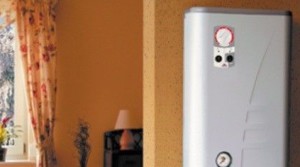 Which heating is better - maybe electricity? If there is sufficient electrical power, well insulated private house can be successfully heated using electricity. At the same time, you should remember and provide alternative heating in case of power outages. When choosing to heat a private house with electricity, there are, of course, many advantages: ease of installation and presentable appearance, and safety of use. However, there are also disadvantages: additional costs for high-quality wiring, increased requirements for the quality of power supply elements. Electric boilers are easy to use, environmentally friendly, safe and silent. If the boiler power exceeds 9 kW, then a three-phase 380 V network is required. In addition to electric boilers, there are heating devices such as electric convectors and infrared emitters, which do not require the installation of a boiler room and installation of heating pipes. For 10 sq.m. area requires approximately 1 kW of convector power, while the power of one convector should be no more than 1.5 kW. To save electricity costs when heating your home, you can use the night tariff and heat the water with electric heating elements in a heat accumulator, and then use it to heat the house in the system. The device is very popular.
Which heating is better - maybe electricity? If there is sufficient electrical power, well insulated private house can be successfully heated using electricity. At the same time, you should remember and provide alternative heating in case of power outages. When choosing to heat a private house with electricity, there are, of course, many advantages: ease of installation and presentable appearance, and safety of use. However, there are also disadvantages: additional costs for high-quality wiring, increased requirements for the quality of power supply elements. Electric boilers are easy to use, environmentally friendly, safe and silent. If the boiler power exceeds 9 kW, then a three-phase 380 V network is required. In addition to electric boilers, there are heating devices such as electric convectors and infrared emitters, which do not require the installation of a boiler room and installation of heating pipes. For 10 sq.m. area requires approximately 1 kW of convector power, while the power of one convector should be no more than 1.5 kW. To save electricity costs when heating your home, you can use the night tariff and heat the water with electric heating elements in a heat accumulator, and then use it to heat the house in the system. The device is very popular.
Heating a private house with liquid fuel is better
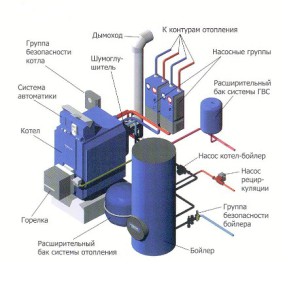 Which heating is better? Diesel fuel is a very common material in all corners of our country, but it is not the cheapest and tends to constant growth. Also, diesel fuel has a peculiar and not pleasant smell for everyone. And although diesel boilers often have a high degree of automation of the boiler operation, installing diesel heating in a private home requires the installation of expensive and complex equipment.
Which heating is better? Diesel fuel is a very common material in all corners of our country, but it is not the cheapest and tends to constant growth. Also, diesel fuel has a peculiar and not pleasant smell for everyone. And although diesel boilers often have a high degree of automation of the boiler operation, installing diesel heating in a private home requires the installation of expensive and complex equipment.
Heating a private house with solid fuel is better
Which heating is better - maybe solid fuel? Solid fuels include: firewood, coal, fuel briquettes. And although they are the most accessible and cheapest, solid fuel boilers are often used where neither electricity nor gas is supplied, since 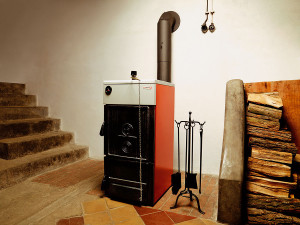 they require constant attention and practically turn the owner of the house into a fireman. To increase the heating autonomy of solid fuel boilers, a heat accumulator is used. Thanks to the heat accumulator, heat accumulates and the number of loads in the boiler is reduced. The thermostat controls the air supply to the combustion chamber, and overheating protection is provided by a special valve and overheat protection heat exchanger.
they require constant attention and practically turn the owner of the house into a fireman. To increase the heating autonomy of solid fuel boilers, a heat accumulator is used. Thanks to the heat accumulator, heat accumulates and the number of loads in the boiler is reduced. The thermostat controls the air supply to the combustion chamber, and overheating protection is provided by a special valve and overheat protection heat exchanger.
Heating a private house with pellets is better
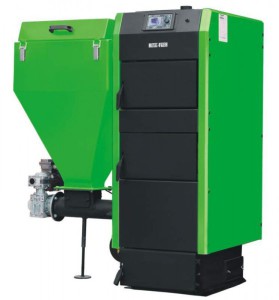 The undoubted advantages of pellet heating include its autonomy and low cost. The disadvantages, of course, are that it is necessary to determine a place for storing pellets. The pellet boiler requires weekly attention, because... it is necessary to clean the burner and add pellets. To increase time continuous operation pellet boiler, you can install an additional pellet hopper. Maybe this heating is better?
The undoubted advantages of pellet heating include its autonomy and low cost. The disadvantages, of course, are that it is necessary to determine a place for storing pellets. The pellet boiler requires weekly attention, because... it is necessary to clean the burner and add pellets. To increase time continuous operation pellet boiler, you can install an additional pellet hopper. Maybe this heating is better?
Heating a private house with multi-fuel boilers is better
What is the best home heating system? Combined boiler rooms are among the most expensive of household boilers; they usually combine three types of boilers at once - solid fuel, electric with a gas or diesel burner. If there are problems with fuel supply or when the house is not heated every day, it often makes sense to install a multi-fuel boiler or combine several heating devices. To increase the degree of automation of a solid fuel boiler, an electric boiler or fireplace with a water circuit is additionally connected to the circuit. The benefit of using multi-fuel boilers is the ability to combine two types of fuel in one equipment and choose the one that is convenient for the owner at the moment type of heating. In a boiler with two fireboxes, you can burn solid fuel and install a burner.
Heating a private home with a heat pump is better
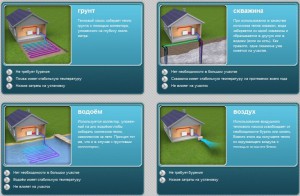 IN recent years Alternative home heating systems are becoming increasingly popular, for example, those built on the basis. The operating principle of a heat pump is simple: the heat pump transfers heat from the street to the house, using low-grade heat sources for its work: earth, groundwater, air. The same principle applies to both the refrigerator and the heat pump. physical principle. Despite the fact that such a heating system has been known for decades, many are stopped by the high initial costs required for its installation. Advantages of using a heat pump: low cost of heating; environmentally friendly, no emissions; the system does not require maintenance.
IN recent years Alternative home heating systems are becoming increasingly popular, for example, those built on the basis. The operating principle of a heat pump is simple: the heat pump transfers heat from the street to the house, using low-grade heat sources for its work: earth, groundwater, air. The same principle applies to both the refrigerator and the heat pump. physical principle. Despite the fact that such a heating system has been known for decades, many are stopped by the high initial costs required for its installation. Advantages of using a heat pump: low cost of heating; environmentally friendly, no emissions; the system does not require maintenance.
It is necessary to decide on the model of the heating system at the stage of planning the house. Now they are presented in various options. To find out which heating is best to choose, you need to know the main characteristics of such structures.
Heating options for a private home
Any type of heating is designed to make human life as comfortable as possible. To heat a private home, heating can be used:
- water;
- steam;
- air;
- electrical;
- open fire structures: stoves, fireplaces.
The choice of heating system depends on the availability of fuel. For example, if there is a central gas pipeline nearby, then it is more profitable to install a gas structure.
Let's try to figure out which artificial heating system is more economical and accessible.
Vodyanoye
Water heating is a closed system through which hot water continuously circulates. The boiler acts as a heating element. Radiators are installed in each room. From the boiler, water circulates through pipes along the circuit and, passing through radiators, gives off heat.

The benefits of a water system depend on the type of fuel used by the boilers. If there is a gas main nearby, then it is wiser to purchase a gas boiler. Gas fuel is considered the most economical. However, such structures require regular maintenance by special services. For non-gasified areas it is better to purchase solid fuel boilers.
Use liquid fuel for a boiler is impractical, since it is expensive and will require the construction of a special tank in the ground for its storage.
Fuel consumption
Example No. 1. Calculation of fuel consumption in a water heating system: gas will act as fuel, since it is the most common. For the calculation, you will need the power of the unit and the area of the heated housing. The boiler power for a private building is determined based on the proportion: 1 kW per 10 m². For a room of 100 m² you will need a 10 kW boiler.
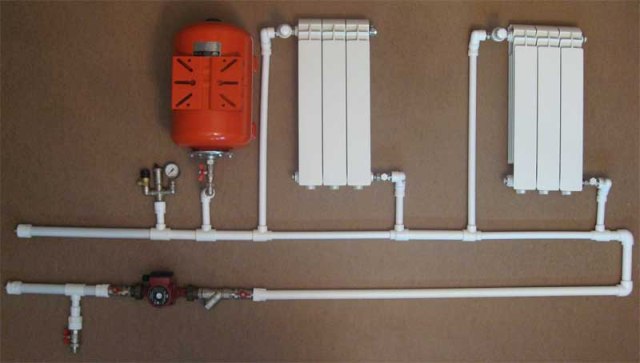
To calculate fuel consumption, it is necessary to multiply the boiler power by 24 hours and by 30 days. As a result, we get 7200 kW/hour. Since the unit does not always work at full power, then this number must be divided by 2. Monthly fuel consumption is approximately 3600 kW/hour. The heating season lasts approximately 7 months. Fuel consumption per heating season equals 3600*7 = 25200 kW/hour.
Considering that 1 m³ of fuel produces 10 kW/hour of energy, we get: 25200/10 = 2520 m³.
Let’s convert the resulting value into a monetary equivalent: the national average cost of gas per 1 m³ is 4.97 rubles. Accordingly, gas heating for the year: 4.97 * 2520 = 12524.40 rubles.
Pros and cons
The main advantages of a water heating system are:
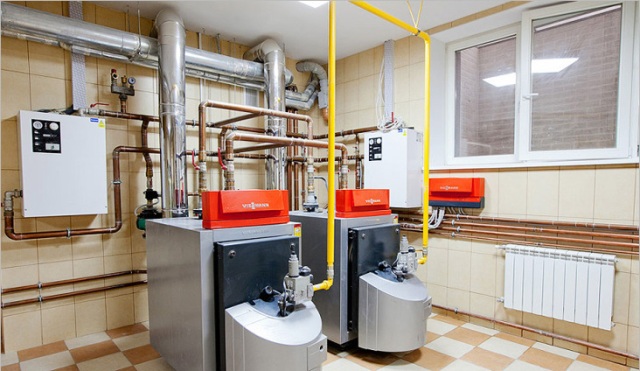
- prompt heating of even a large room;
- quiet operation;
- ensuring the same temperature in all rooms;
- fuel economy;
- ease of maintenance and repair;
- increase in operational life.
Disadvantages include the labor-intensive installation of the installation compared to other systems, the need for constant monitoring of the operation of the boiler, as well as the need to remove water before preserving the system.
Steam heating: advantages and disadvantages
It involves the following mechanism: in the boiler, water is heated to boiling temperature, and the resulting steam enters the radiators. The steam then condenses into liquid and returns back to the boiler.
Advantages:

- high heating rate regardless of the area of the house;
- no heat loss in heat exchangers;
- ecological purity of the coolant;
- cyclical coolant - steam can be used several times;
- minimal probability of freezing of the structure.
There are also negative aspects such heating:
- there is no way to regulate the temperature inside the house;
- short service life of the system due to high temperature coolant;
- high probability of corrosion under the influence of vapors;
- the need to install a grill.
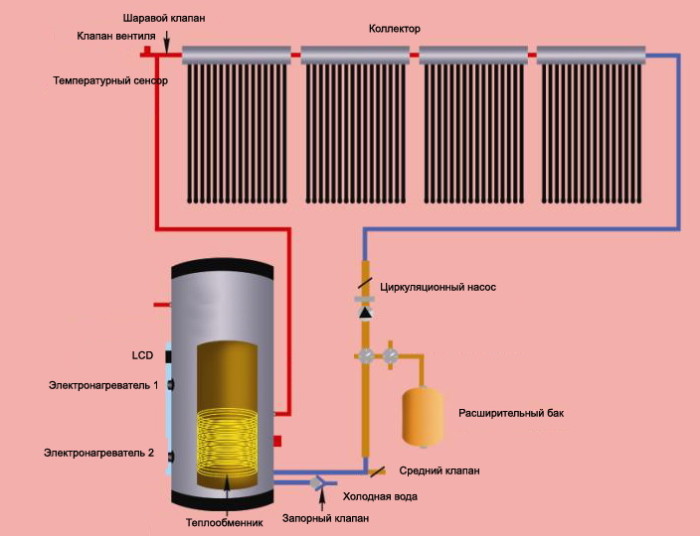
The boiler can operate on the basis of gas, solid, liquid or combined fuel. In order for the heat transfer of equipment to be as efficient as possible, it is necessary to choose it correctly. So, to heat a private house with an area of 60 - 200 m², a unit with a capacity of 25 kW is required (if the area is 200-300 m², then the boiler power must be at least 30 kW).
A steam heating system can operate on various fuels: gas, wood, electricity, coal. To heat a home, combined heating options are increasingly being used, for example: gas and electric.
By wisely combining fuel, you can save on heating your home.
How much fuel will be required
Example 2. Calculation of gas consumption for steam heating. Let's assume the area of a private house is 100 m². Accordingly, the boiler power for heating is 25 kW.
- 25 kW*24 hours*30 days = 18000 kW/hour. This figure does not reflect adequate situation, since the boiler does not always operate at full capacity. The average value in this case is more acceptable.
18000 /2 = 9000 kW/hour. - 7 months *9000 kW/hour = 63000 kW/hour - annual fuel consumption.
- Considering that 1 m³ of fuel produces 10 kW/hour of energy, we get: 63000/10 = 6300 m³.
- In monetary terms: 6300 * 4.97 = 31311 rubles per year.
Electrical
Involves the use of infrared heaters, electric convectors or underfloor heating.
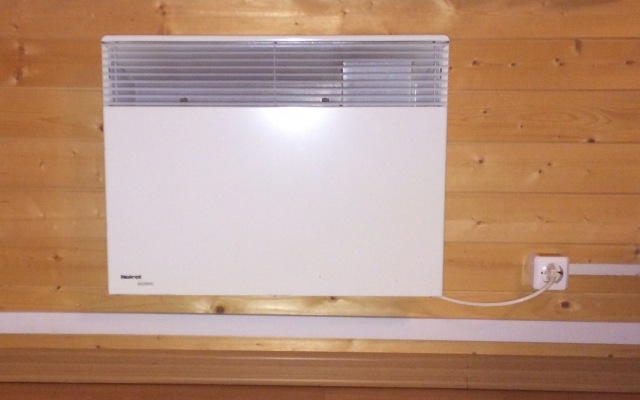
This option is less economical than gas heating, as the cost of electricity is high. It is best to use it only when other options are not available.
Advantages and disadvantages
Among positive aspects The use of such a heating system is distinguished:
- the ability to use an electric boiler to heat various liquids;
- low costs for purchasing an electric heating system;
- no need for operational maintenance;
- ecologically safe way maintaining the desired temperature in the room;
- the ability to simultaneously install hot water supply along with the heating system.
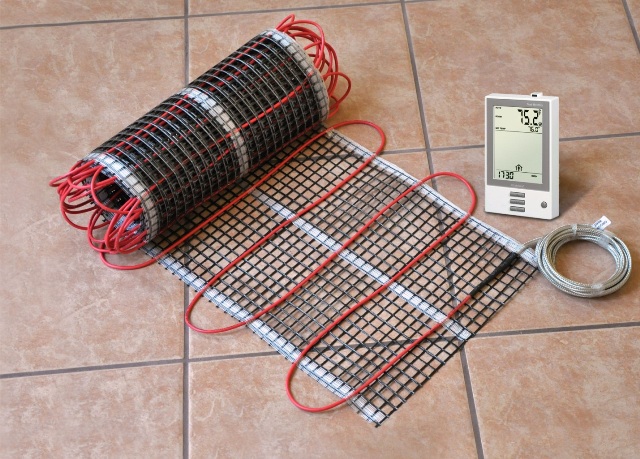
Electric heating also has disadvantages. Power consumption sometimes reaches 24 kW/hour. Such heating is subject to increased safety requirements. Power outages disrupt the system. Certain inconveniences are caused by the need to install a multiphase distributor, since many electrical networks cannot withstand high voltage. Good thermal insulation of the house is also necessary.
Consumption
Example No. 3. Calculation of electricity consumption. Let's assume that the area of the house is 100 m². To heat it, you will need a 10 kW unit (1 kW per 10 m² of area). The number of months in the heating season is 7.
- Monthly fuel consumption: 10 kW *24 hours* 30 days = 7200 kW.
- Average value: 7200 / 2 = 3600 kW.
- Annual fuel consumption: 3600 kW * 7 months = 25200 kW. Let's convert the resulting value into m³: 25200/10 = 2520 m³.
- Monetary value: 2520 * 4.97 = 12524, 40 rubles per year.
Air heating
The air heating system consists of a heat generator and a water heater responsible for heating the air. Thanks to the fan and distribution heads, air masses are distributed throughout the house.
Characteristics
The advantages of an air heating system are: high efficiency (93%), the ability to warm up a room in the shortest possible time, and maintaining an optimal temperature. Also, a heating system with an air intake can be equipped with air ionizers or cleaning filters.
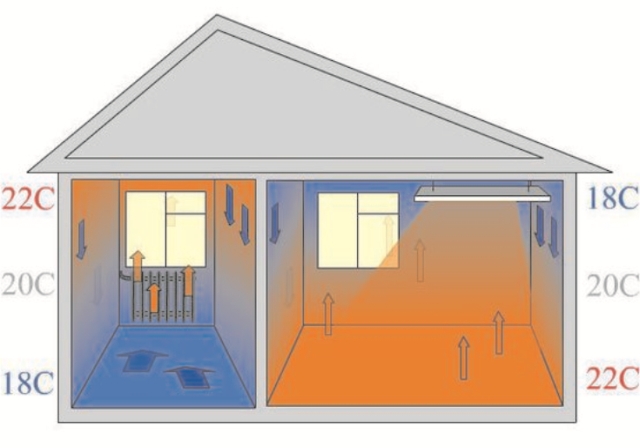
The disadvantages of air heating include the following:
- an air heating system can only be installed during the construction of a house;
- regular maintenance is required;
- high demand for electricity (required additional source power supply);
- Air filters need to be changed frequently;
- high installation and maintenance costs;
- drawing in dust from the street (applies only to a forced draft system).
The air heating system can use gas or diesel fuel. The calculation of fuel consumption is similar to example No. 1.
Stove heating
Stoves and fireplaces are used to heat homes. For cottages, these options are ineffective, since they do not ensure uniform distribution of heat throughout the rooms. They are best chosen for use in dachas.
To decide which heating is most suitable for a private home, you need to choose the cheapest and most accessible fuel in your area. The price of artificial heating of a residential building directly depends on its consumption and cost. There is no universal option. Gas remains the most economical source of thermal energy. In an area where there is no main gas pipelines, you should pay attention to solid fuel and electrical resources.
The variety of heating systems for a private home not only amazes with its capabilities, but also causes significant difficulties in choosing. The question arises: which heating system to choose? Which heating is better? The point is, everything existing options heating systems do an excellent job of their main task, but if you do not take into account the conditions in which the heating system will be operated, then it may be inconvenient to use or too costly to maintain.
Heating with solid and liquid fuels
Solid fuel should mean firewood, pellets, briquettes, etc. Fireplaces, stoves and water heating boilers operate on this type of fuel. It is well known that fireplaces are ineffective as a heating system and are only good for the interior. Therefore, stoves and solid fuel boilers are of greatest interest.
Compared to other heating systems, stoves are low efficient and labor-intensive to maintain, so even in the absence of other energy sources, it is not advisable to use stoves as the main heating for a private home. However, if we're talking about about a small house that is in winter period is visited infrequently and for a short time, for example, a dacha, then the stove is the most best system heating, especially when it comes to gas generator-type stoves. Using a wood-burning stove, you can quickly warm up a room, the cost of fuel and its consumption with this method of operation is low, the cost of the stove is significantly lower than the cost of any other heating system, and installation is simpler.
Increase 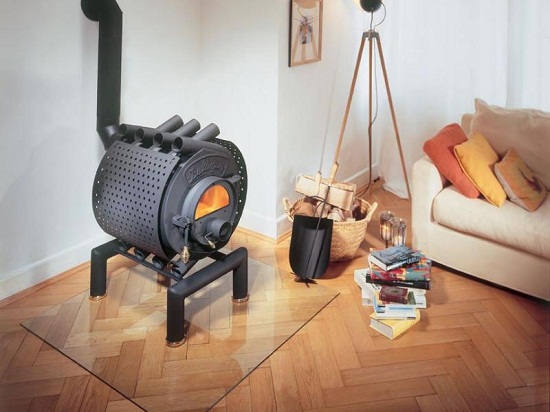
Fig.1.
If the house is intended for permanent residence, there is no gas main and there are interruptions in the power supply, then the only way out is water heating based on a solid fuel boiler. When choosing this type of heating system, you should remember that you must constantly monitor the boiler and the remaining amount of fuel, have a supply of fuel, and you must not leave the boiler unattended. long time, because If the fuel runs out, the heating system will quickly cool down and may defrost.
Increase 
Fig.2.
An alternative to solid fuel boilers are liquefied fuel boilers. Liquefied fuel includes liquefied gas and diesel fuel. Of course, this method of heating a house will cost more than servicing a solid fuel boiler, but such systems require less attention.
Gas heating at home
Most heating systems use gas as the main fuel. The reason is simple, gas heating is the cheapest option. Heating system on natural gas easy to install, and gas boilers are available in various configurations, which allows you to automate the heating system 100%. Considering the ease of operation and low cost source of energy today is best option heating systems.
Gas boilers for heating systems can be divided into floor-mounted and wall-mounted. These types of boilers differ in power and installation method.
Floor-standing boilers have greater power and are designed for heating large areas, usually more than 250 square meters. m. Boilers of this type require a special room - a boiler room. The boiler room must have ventilation. Floor-standing boilers require a separate chimney.
Increase 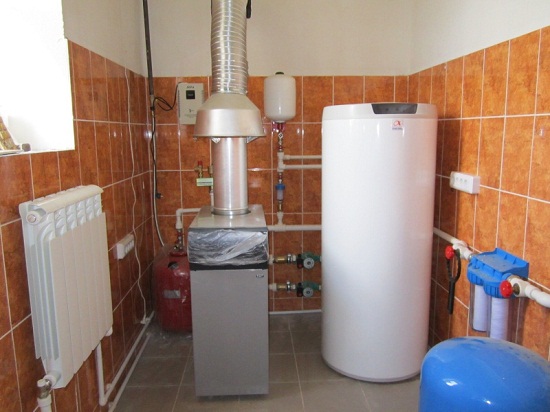
Fig.3.
Wall-mounted gas boilers are more compact and are usually designed for heating a house with an area of up to 250 sq.m. Wall-mounted boilers are equipped with all necessary automation. Most models already have an expansion tank and a circulation pump in their design, which greatly simplifies the installation of the heating system and its adjustment. Some models have 2 heating circuits and are capable of working not only for the heating system, but also for heating water for the water supply of the house.
Increase 
Fig.4.
The most interesting for a small house are boilers with a closed combustion chamber. This type of boiler does not require a separate chimney and boiler room. Exhaust gases and air flow to the boiler are carried out using a coaxial pipe, which is mounted in the wall next to the boiler. Boilers of this type greatly simplify the installation of a heating system. Therefore, subject to the stability of the electrical network, this type of boiler turns out to be the best for systems gas heating small house.
Increase 
Fig.5.
Electric heating
Electric heating only possible if there is an uninterrupted supply of electricity. This type of heating is used when there is no gas supply and it is impossible to constantly monitor the heating system, as when using a solid fuel boiler.
There are many options for electric heating systems, but only two types are suitable for water heating systems: electric boilers and heat pumps.
In addition to electric boilers with heating elements heaters, which are uneconomical, there are electrode boilers and induction boilers. The efficiency of boilers of this type is close to 100%, which in terms of operating costs puts them on par with solid fuel and gas systems. These types of electric boilers have advantages over gas and solid fuel ones: they have small overall dimensions and are easy to install, they do not require the installation of a chimney, electric boilers allow you to regulate the temperature in a very wide range. All these advantages lead to the fact that they are often preferred, especially if it is necessary to heat a small house.
Increase 
Fig.6.
Another option for electric home heating is a heat pump. A heat pump extracts low-grade energy from the environment and converts it into heat. The most popular are heat pumps that extract energy from the ground or well. The extracted heat is transferred to freon, which is then transferred to the coolant of the heating system.
The main advantage of heat pumps is the transformation coefficient, which can reach 5. This means that for every kW of electricity invested, the heat pump produces 5 kW of heat. Thus, from an economical point of view, a heat pump is significantly better than other types of electric heating.
Increase 
Fig.7.
The main disadvantage of a heat pump is the cost of equipment and complex and expensive installation associated with laying an external collector. However, if we are talking about the need to create a heating system for a house under gas supply conditions, then a heat pump is better heating country house, both in terms of operating cost and ease of management.
If it is not possible to install a water heating system, a good alternative is infrared heating. Use as separate infrared heaters, and film infrared heaters. The film type is the most popular, because it can be installed hidden and not clutter up the living space. The film can be installed under the floor covering or under a suspended ceiling. The last option for heating is preferable, since on the way thermal radiation furniture will not stand. Such an electric heating system can be used perfectly in any type of house (permanent or temporary residence).
Increase 
Fig.8.
TO electrical systems heating systems include all kinds of electric heaters. The most economical are convectors. However, they are still inferior to the heating systems considered in terms of energy costs, so it is advisable to use them to heat a house only as an additional heater or for temporary heating.
Options for water heating systems
Abundance possible options Heat sources in the heating system are of course striking in their diversity, but it would also seem simple system water heating also has various options execution. Therefore, when assessing which heating system is better, you must not ignore this topic.
Water heating systems can be divided into two types: dependent on an electricity source and independent. This is relevant when there are problems with the stability of the power supply.
Energone dependent system is not only a completely autonomous boiler, but also a water heating system in which there is no circulation pump. Non-volatile systems use solid fuel and gas boilers. The water heating system is open. In this system, coolant circulation is carried out due to the difference in density of heated and cooled water. Therefore, for good circulation, it is important to provide for the slope of the heating pipes and to correctly position the boiler and expansion tank.
Increase 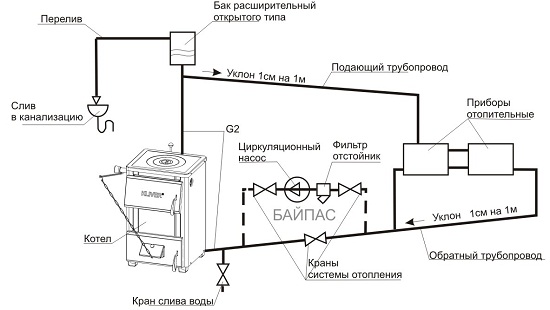
Fig.9.
As a trade-off for being independent from power supply, the open system is quite bulky. Another disadvantage is the inconvenient location of the boiler and expansion tank. Regular checking of the coolant level is also required. As for the boilers used, the boilers in open system have minimal control functions, i.e. It becomes impossible to automatically control such a heating system.
A dependent system, a closed type system, does not have all of the above disadvantages. In this system, the coolant is circulated by an electric pump, and any boiler can be used as a heater. A closed system is easier to control, more compact and easier to install.
Increase 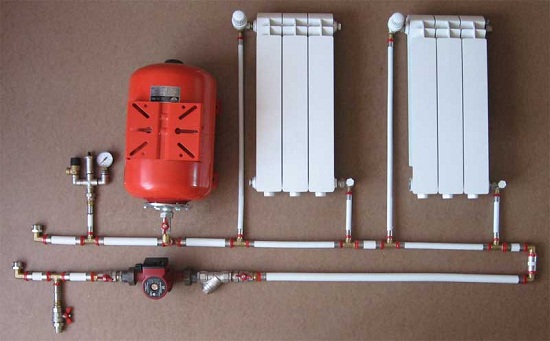
Fig. 10.
In addition to the options for the system itself, there are also different connection diagrams for heating devices. There is a single-pipe, two-pipe and beam scheme. A one-pipe scheme is when all heating devices are connected in series to one pipe. In a two-pipe scheme, heating devices are connected in parallel; this requires the presence of two pipes. In a beam circuit, all devices are connected independently to the collector.
Increase 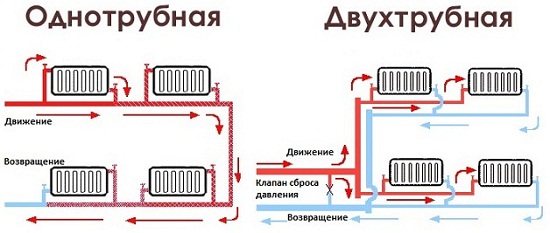
Fig. 11.
From the point of view of saving on material and installation, the best is single-pipe scheme. Its disadvantage is the complex adjustment of the heating system. To get an easily customizable heating system, it is better to choose a two-pipe scheme. If you want to be able to save on heating or install heated floors, then it is better to prefer a radial scheme. In this case, savings are achieved due to the fact that, using a beam circuit, each heating device can be adjusted to your temperature. Thus in non-residential premises You can maintain a minimum temperature, which results in good savings on heating.
Taking into account all of the above, it becomes possible to answer the question of which heating is better for a home. The best heating is the one that is the cheapest to operate and does not require constant adjustment to changing climatic conditions.
One of the most important engineering networks of a home is the system that provides heat to residents. Without high-quality heating, there can be no talk of any coziness and comfort. Therefore, every owner of his own home wants to know what kind of heating to install in a private house, especially if he builds it with his own hands. Read on to learn about the most popular options, their advantages, disadvantages and features.
Criteria for choosing a climate system
There is no universal answer to the question of how best to install heating in a private home. It all depends on local conditions, individual preferences, cost and availability of various coolants in your area, as well as other factors.
However, there is a small instruction, following the rules of which you can choose the best option for yourself, so that you do not regret your decision later.
So, the best heating for a private home must meet the following criteria:
- The power of the climate network must be sufficient to provide all rooms of the cottage with thermal energy. In addition, it is desirable that a minimum amount of energy resources be used to maintain its operation.
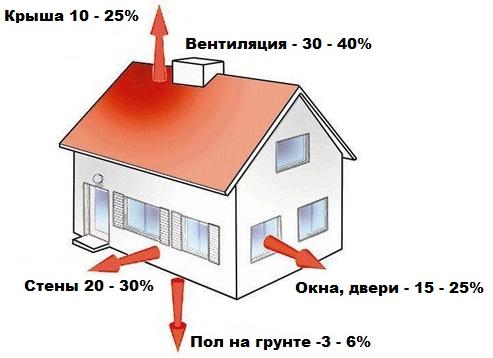
Advice! When choosing a particular type of heating system, ask what the price of the fuel used by the boiler is. Perhaps the operating costs will be too high, so it would be advisable to choose another option.
- Heating should function independently, if possible without human intervention. Ideal option– turned it on, set the operating modes and forgot. Therefore, when choosing which heating system is best for your home, give preference automated systems.
- Capital investments in climate control equipment should not be too high. For example, one of the most economical systems is a heat pump, but the cost of constructing such heating can sometimes exceed the price you paid for a small cottage.
- Installation of the selected heating circuit, as well as its maintenance, should not be too complicated. Ideally, it is advisable to choose a type of heating that you can install, put into operation and repair yourself.
![]()
Heating schemes for country cottages
Having familiarized ourselves with the requirements, let's figure out what types of heating systems there are in a private home, what are their strengths and weaknesses. For ease of presentation, all the advantages and disadvantages various equipment presented in the form of tables.
Scheme 1. Air
There is a possibility to heat country house by using . Thus, a comfortable microclimate is often maintained in industrial premises and commercial buildings.
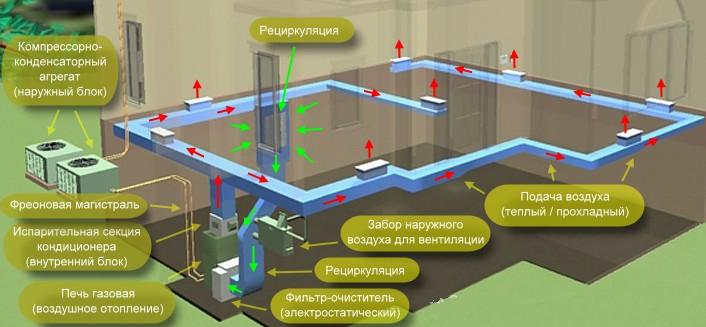
The operation scheme of such an installation is extremely simple: in a special device - a heater or recuperator - air masses pumped from the street are heated to the required temperature, after which they are distributed through specially designed air ducts throughout all rooms of the house.
The advantages and disadvantages of the described system are as follows:
| Pros | Cons |
| The heating system operates without liquid coolant circulating in pipes and heating radiators. Consequently, you are initially protected from leaks, freezing, airing and other similar troubles. | The equipment used to construct an air heating system is quite expensive. In addition, installation of ventilation ducts will be required. Be prepared for significant material costs. |
| not only heats the air, but also stabilizes its humidity, which allows you to create a more comfortable microclimate in the house. | To install a massive and large heat generator with fans, which is the central element of the system, you need to allocate a separate room. |
| An air heating system can be designed to not only heat the air, but also cool it if necessary, and also purify rooms from unpleasant odor, smoke and so on. | Air heating works on the principle of constant air circulation. The latter, moving around the room, raises the dust in it. To avoid this, it is necessary to provide for the installation of filters. |
| This utility network has a fairly high efficiency - equipment operating efficiency reaches 90%. | Ventilation system heated air makes noise during operation, which can cause inconvenience to the inhabitants of the house. |
| Heating rooms using warm air has low inertia. As soon as you turn on the heating system, the rooms will become noticeably warmer, which is very important for houses and cottages that are not intended for year-round use. | Air heating has a relatively low degree of heat transfer. Therefore, in order to maintain the desired air temperature, it is necessary to pump large volumes of air, which consumes electricity. |

According to collected statistics, this heating method is used in approximately a quarter of houses under construction. Air heating is expensive to install, but it will be an excellent choice for small cottages that you plan to visit only from time to time.
Scheme 2. Electrical
Another popular option is to use electricity. These can be convectors that replace conventional heating radiators, or infrared films installed on the ceiling.
![]()
Let's consider the positive and negative aspects use of such systems.
| Pros | Cons |
| Heating with electricity is the most environmentally friendly. When operating the equipment, it is not released into the environment harmful products combustion. Even if the heating device breaks down, no harmful substances will not pollute nature. | Electricity as an energy carrier is quite expensive. Among all the types of existing fuel, electricity is the most expensive. Therefore, such a system is not suitable for heating a large house, since the cost of paying for services will be too high. |
| Electric heating devices are quite simple. They do not require periodic maintenance and special handling during operation. | During their operation, electric heaters burn oxygen and lower the humidity level in the room. Therefore, while working like this heating equipment it is necessary to organize additional ventilation. |
| Installing electric heating in your home is quite simple. You just need to place a sufficient number of convectors in the appropriate places and connect them to electricity. We are not talking about any installation of pipes. | The climate system is completely dependent on external engineering networks. A broken electrical wire, which often happens in rural areas, will leave you completely without heat. |
| Electric heating devices can be either wall-mounted or mounted on legs. In the latter case, you have the opportunity to freely choose the location of their installation, creating the most comfortable microclimate for yourself. | Electric climate control equipment consumes large number electricity. Therefore, before installing such a system, it is necessary to make sure that the wiring in the house and main power lines are designed to supply such a volume of electricity. |
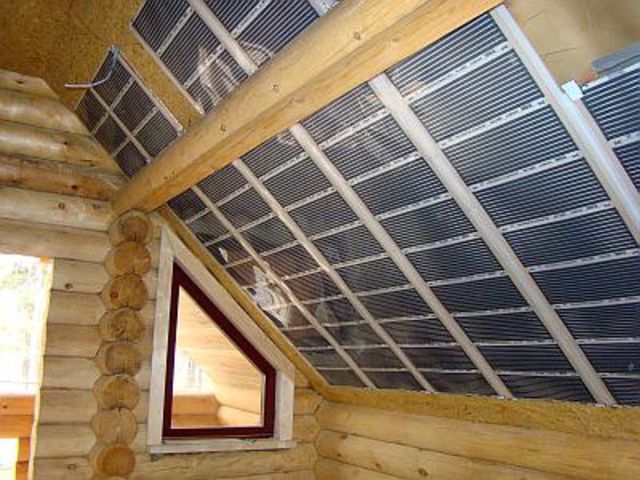
Analysis modern trends The market for climate control equipment shows that electric heating has good development trends. New, more economical electric heaters are appearing, and modern thermal insulation materials make it possible to reduce unproductive heat consumption to a minimum.
![]()
Advice! Electric heating can be used as backup or additional. For example, you can organize heating of the rooms of the house using a solid fuel boiler, after which a comfortable temperature will be maintained by convectors or infrared emitters.
Scheme 3. Water
The heating system with liquid coolant is one of the most common. The scheme of its operation is as follows: the liquid heated by the boiler (water or special antifreeze) is supplied through laid pipes to the installed heating radiators, where it releases thermal energy air in the room.

The heat source is a heating unit that can operate at the following types fuel:
- liquid - diesel fuel or waste machine oil;
- solid – firewood, coal, fuel briquettes or biofuel pellets;
- gaseous – main or liquefied gas;
- electricity - in this case, unlike described above, a boiler is used rather than convectors or infrared heaters.
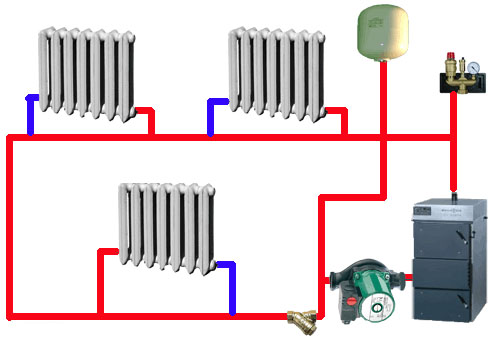
Its advantages and disadvantages are as follows:
| Pros | Cons |
| Water is perhaps the cheapest, most widely available and safe coolant, the use of which does not cause harm environment and human health. | To save high efficiency It is necessary to constantly clean heating radiators, since dust interferes with normal heat exchange. |
| The amount of coolant poured into a closed heating system does not decrease (especially if a closed expansion tank is used), so there is no need to add purchased antifreeze. | The system has great inertia. After switching on, quite a long time must pass before the temperature in the house rises to required mark. A circulation pump will help speed up the process by increasing the speed of water flow. |
| A water heating system with a boiler can be installed completely independently. The exception is gas boilers, the installation of which is carried out by certified workers after obtaining the appropriate permit. | Metal elements heating system are susceptible to corrosion, as a result of which climate network may leak. It’s easy to protect yourself from this trouble: you need to use polymer pipes. |
| The use of several circuits or a radiant heating system allows you to very accurately regulate the temperature in individual rooms of the house. | Water poured into pipes must be cleaned of minerals, acids and alkalis dissolved in it, which can damage heating equipment. |
| The presence of a double-circuit heating boiler allows you to provide the residents of the house not only with heat, but also hot water For household needs, eliminating the need to purchase additional expensive water heating equipment. | Water system heating is not suitable for houses where people are not expected to live all year round, since after the heating boiler is turned off, the liquid in the pipes and radiators can freeze and render the equipment unusable. |
![]()
A water heating system is most often used to heat private houses. And if the coolant is heated by a gas boiler, then it is also the most economical, efficient and ergonomic.
To make the heating system of a private home as efficient as possible, it is recommended to combine two heating schemes:
- use radiators with aluminum heat exchangers (even better - bimetallic), with the help of which you can organize the most efficient and fast heating of rooms;
- install a water heated floor system in the house that will maintain a comfortable temperature with minimal energy consumption.

The fact is that heating radiators heat the air, which then rises to the ceiling. Therefore, to ensure the heating of air masses at floor level to a comfortable temperature, which is considered + 18 o C, it is necessary that this indicator for the entire room be at least + 25 o C, which increases heating costs. When using a heated floor system, this disadvantage can be avoided.
But you can’t do without radiators. They reduce the inertia of the system. Organizing convection air flow, these elements of the heating network warm up the air faster.
Advice! It is advisable to make separate heating circuits for radiators and floor heating systems. Then you will be able to regulate temperature indicators more accurately, achieving greater comfort and saving coolants.
Conclusion
After analyzing the advantages and disadvantages of each of the schemes offered to your attention, you can decide for yourself which heating is best for your home. You can learn about other engineering networks that provide comfort to the inhabitants of the house from the video posted in this article.
What is the best way to make heating in a private house? When installing a heating system with your own hands, you will be faced with the problem of choosing pipes, radiators and, most importantly, a heat source.
The purpose of this article is to provide you with information about modern market heating equipment.
Choosing a heating method is one of the main problems that the owner of a private home has to solve.
Evaluation criteria
What is meant by “better heating”?
Let's formulate the criteria that the selected materials and heat source must meet.
- Our project should provide the house with a sufficient amount of thermal energy with minimal operating costs. And not only at the moment, but also in the near future.
- Heating should require as little of our attention as possible. Ideally, the heat source should operate completely autonomously, using the “set it and forget it” principle.
- The cost of equipment should not be prohibitive either. Yes, heating lasts for many years; but if it turns out to be more expensive than the house that needs to be heated, it will still be a bit of an overkill.
- Installation, if possible, should not be prohibitively complex and require specific knowledge and skills. In addition, it is advisable to avoid additional expenses in the form of purchasing expensive tools and equipment.
Terms
To decide which heating is best for the home, we should also determine some external conditions.
These are the features of the operation of heating equipment in an autonomous system, current prices for various energy sources and the expected dynamics of prices for them in the near future.
- If in systems central heating Temperature and pressure are quite unpredictable, but you have complete control over the parameters of the autonomous heating system.
All modern boilers allow you to forcibly limit the heating of the coolant to a certain value.
![]()
Many gas and electric boilers are able to control air temperature. The photo shows a remote thermostat.
However: if you are careless, water hammer in the circuit can be organized here too. For example, simply by abruptly opening a jumper valve with cold water supply. But we won't do that, will we?
- Another scourge of central heating is the formation of galvanic pairs between different metals. For example, if you installed aluminum radiators for yourself, and your neighbor installed a copper liner, then in salt-rich water a constant weak current will arise between the metals. Migration of ions from electrode to electrode will lead to accelerated erosion inner surface.
- Based on the cheapness of a kilowatt-hour of thermal energy, heat sources can be arranged in the following order:
- Main gas.
- Firewood.
- Coal.
- Bottled gas.
- Solar oil.
- Electricity.
In this case, the order may change (it is strongly influenced by the regional price of the corresponding fuel); however, in any area, gas will remain the cheapest fuel and electricity the most expensive.
- In the coming years, electricity and energy prices will continue to rise. But not on an equal basis with each other.
Fossil fuels, whose reserves are very limited and will run out in the coming decades, will rise in price tenfold. In fact, European gas prices are already 8-10 times higher than Russian ones.
Firewood is a completely renewable resource; Moreover, there is already such a thing as “energy forests” - fast-growing trees that are grown as fuel. They will rise in price to a much lesser extent.
Finally, in the next two decades, electricity tariffs are expected to increase by only 2 to 2.5 times. Energy will gradually switch to renewable sources, primarily solar panels and wind generators. They mean a large initial investment but extremely modest operating costs.

Shopping
So, what kind of heating should be done in a private house, taking into account all the above calculations?
Heating devices
The optimal combination is a water heated floor laid with cross-linked polyethylene pipes. What is this instruction related to? Arguments are at your service.
Heated floors are more economical than convection heating with radiators due to more rational heat distribution. If, in order to provide a minimum comfortable +18 at the floor level, the radiators have to heat the air under the ceiling to at least +25C, then in the case of a heated floor, these +25 will be directly above the floor.
But in the upper part of the room, where heat is not needed, the temperature will be noticeably lower.
Please note: the higher the air temperature under the ceiling, the more heat is lost through the roof. It is thanks to the reduction of heat leakage that underfloor heating provides noticeable savings.
Why was cross-linked polyethylene chosen?
There are several reasons:
- These pipes have excellent flexibility and can be laid in a snake or spiral with a minimum bend radius without risk of damage.
- They are supplied in coils. The main requirement for warm floor During installation, do not place connections of any type into the screed. The ability to cut a single piece of pipe to any length makes this a breeze.
- At the same time, pipes made of cross-linked polyethylene are much cheaper than, for example, one of the materials that competes in terms of quality - corrugated stainless pipe.
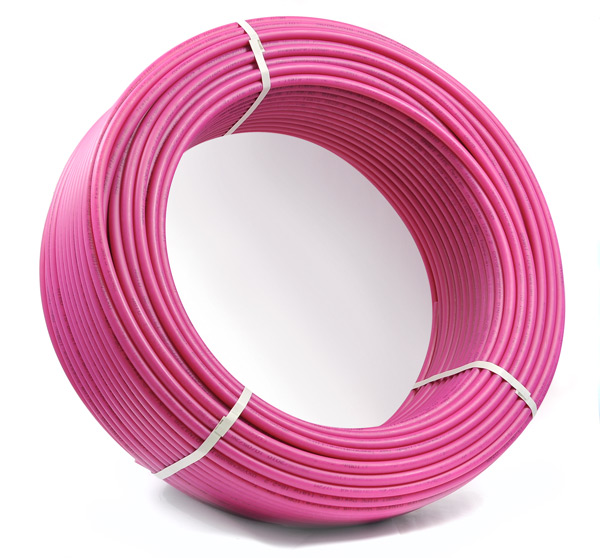
The wholesale cost of a linear meter is 33 rubles.
Useful: to install connections with fittings, a rather expensive tool is used - an expander.
The pipe has a kind of molecular memory: if you stretch it and put it on the fitting, then through short time it will squeeze it very tightly.
After fixing with a locking ring, the connection will become almost permanent.
To stretch a pipe, you need a tool that develops a lot of force.
Its retail price starts from approximately 15-17 thousand rubles.
However, let’s not dramatize the situation: it’s easy to rent it for the duration of heating installation.
Radiators, however, are also useful: they quickly warm up the room after lighting the boiler due to their low thermal inertia and, importantly, create a thermal curtain under window openings. In this way, we will avoid drafts and the appearance of condensation and frost on cold glasses.
Aluminum batteries are preferable because they provide maximum heat transfer per section at a minimum cost.
Pourings and eyeliners
For them, we can recommend polypropylene pipes reinforced with fiber or aluminum. The advantage of the material is its very simple installation, requiring the use of inexpensive tools. Durability and service life are more than sufficient for autonomous system heating.
Why is reinforcement needed?
- It increases the tensile strength of the pipe. Not that this is necessary for a circuit in which the pressure does not exceed 2 kgf/cm2; but the margin of safety with a small difference in cost has never hurt anyone.
- More importantly, polypropylene has a very high coefficient of thermal expansion. To solve this problem, when installing pipes several meters long, it is necessary to equip them with compensators - U-shaped or round bends. Reinforcement reduces linear expansion to the level of the steel pipe.

Aluminum or fiber?
Essentially it's a matter of personal preference.
- Aluminum foil, as is commonly believed, protects the coolant from oxygen saturation through the pipe walls, which are partially permeable to air. However, the author has a strong impression that the danger of this process is greatly exaggerated by manufacturers of foil pipes for advertising purposes.
- Fiberglass reinforcement provides quite tangible benefits: when welding pipes with fittings, they do not require stripping of foil. The installation process is noticeably simplified and accelerated.
What pipe diameter should I use?
The answer to this question is inextricably linked with what types of heating systems there are in a private home.
- For bottling in systems with natural circulation, pipes with internal section not less than 32 millimeters, which corresponds to an outer diameter of 40 mm.
- For forced circulation systems with a reasonable area of the house, a DN20 pipe (external diameter 25 mm) is sufficient. The same pipe diameter is used to connect the radiators.
The exception is collector wiring, when each heating device has its own pair of pipes from the collector. In this case, a cross-linked polyethylene pipe with an outer diameter of 16 mm is usually used. However, it is quite difficult to combine radiant wiring and heated floors in one room.
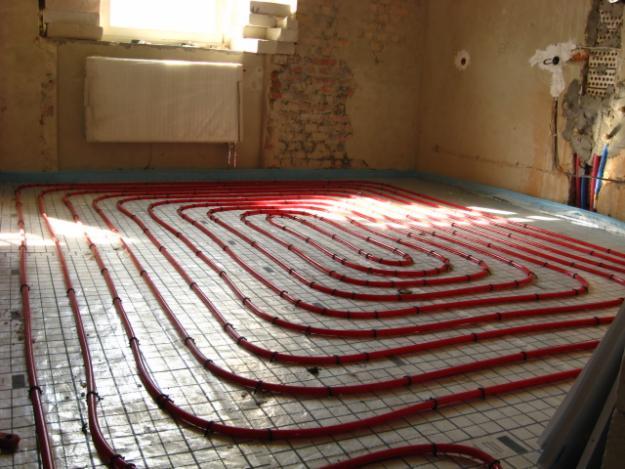
Heat source
Finally, we come to the main problem. Which home heating is better in terms of source of thermal energy?
The answer to this question depends on several factors:
- With winter temperatures. For the average temperature of the coldest month at +1 and -50, completely different solutions are suitable.
- With the presence of a gas main in close proximity to your home. If there is no gas in your locality, in any case you will have to abandon the idea of using it for heating: pulling a line tens of kilometers away... let’s just say, it’s a little expensive.
- It depends on how much money you are willing to invest in heating, taking into account long-term (10-20 years) prospects.
Most cheap source heat now, as already mentioned - main gas. The best heating device in terms of the ratio of functionality and convenience is a condensing boiler with a storage water heater for DHW needs.
What is the choice related to?
- By using the heat of condensation of combustion products, a condensing boiler provides the highest possible efficiency, 10-12 percent higher than the efficiency of traditional solutions.
- Devices of this class require low return temperatures, which is to our advantage. Warm floor, remember?
- A storage water heater is convenient because it provides a more stable temperature of hot water compared to a flow one. In addition, it requires less thermal power.

If there is no gas main nearby, a natural alternative is a solid fuel boiler complete with a heat accumulator (a thermally insulated container with a volume of up to 3 m3). Costs will be minimal if you prepare firewood yourself; however, the need to purchase wood or coal will not put you on the brink of bankruptcy either.
The function of the heat accumulator is to make it possible to make kindling less frequent, and the operating mode of the boiler to be optimal. All solid fuel boilers achieve maximum efficiency at rated thermal power. Adjusting the combustion process using dampers leads to incomplete combustion of fuel.
Finally, by far the best heating solution for a private home, considering the future, is a heat pump.
There are three main scenarios possible.
- In warm climates, it is possible to use air-to-water pumps, or even heat with conventional inverter air conditioners. They are capable of pumping up to 5 kilowatts of heat into a house for every kilowatt of electrical power.
The last option is used by the author of the article. Location - south coast Crimea, the cost of heating a 75-meter residential floor does not exceed 1,500 rubles. The cost of the project is attractive: a pair of air conditioners with installation cost only 40,000. - If your level is high groundwater or there is a non-freezing reservoir nearby, the water-water pump will great solution. The total cost of the solution, however, will increase to 7-10 thousand euros.
- Finally, a geothermal pump with installation, including drilling wells, costs at least 13-15 thousand euros. However, such a scheme is most independent of external conditions. The approximate service life of the pump is 30-50 years.
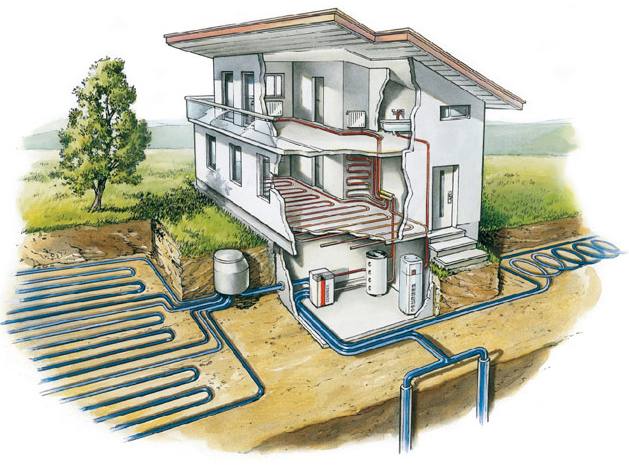
Conclusion
Of course, the article expresses subjective opinion the author and does not claim to be the ultimate truth. You can see one of the alternative points of view in the attached video.





